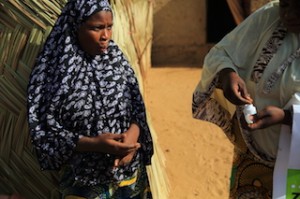Niger revises strategies for schistosomiasis treatment and assessment
February 3rd, 2015
The West African country of Niger has been struggling for many years to control the spread of schistosomiasis, a neglected tropical disease caused by contact with tiny parasitic worms called schistosomes, which live in fresh water lakes and rivers. Even after more than seven years of almost nationwide mass treatments to prevent or cure the disease, infection rates have remained high in some districts.

Rivers contaminated with infected snails can transmit schistosomiasis to children and adults
Photo © HKI
Seeking to address and improve this situation, Niger’s NTD program sat down with its partners at END in Africa, including representatives from FHI360 and Helen Keller International, as well as partners at the Schistosomiasis Control Initiative (SCI) and the International Network for Planning and Control of Schistosomiasis (RISEAL), in November 2014. Representatives from the University of Niger, the Ministries of Education and Health also attended the meeting, as did personnel from the NTD program, including a number of regional and district health directors. The goal was to revamp the country’s schistosomiasis (bilharzia) treatment strategy and to bring it into closer alignment with the new treatment strategy that had been recommended by the World Health Organization in 2012.
The 2012 WHO guidelines recommended:
- Conducting serology tests in districts with infection rates below 1%, and administering mass drug treatments only in communities where at least one resident tests positive for bilharzia. In such communities, treatment would continue to be provided every two years.
- Providing mass drug treatment every other year in districts with bilharzia infection rates equal to or above 1%, but below 10%.
- Maintaining the previous treatment frequency (annually in the ten districts bordering the Niger river; and every two years in the remaining districts) in districts with infection rates equal to or above 10%, but below 50%.
- Providing mass drug treatments twice a year in districts with infection rates of 50% or higher.
Before 2014, Niger’s treatment strategy had been to provide annual mass drug treatments in ten health districts (HDs) along the Niger River. In 31 other districts, such treatments were administered only once every two years, irrespective of the percentage of infections among local residents reported in disease assessment surveys.
In preparation for aligning the country’s treatment strategy with the 2012 WHO guidelines, Niger’s bilharzia program conducted new national surveillance surveys between 2011 and 2013, with support from END in Africa and other partners. The new surveys enabled the program to compile more recent data on infection rates in the 41 districts where bilharzia is found.
Using the 2012 WHO treatment guidelines as well as the information gleaned from the 2011-2013 surveys, Niger’s NTD program and partners used the November 2014 meeting to come to a consensus on a new bilharzia treatment strategy for the country. The new strategy generally dovetails the WHO standard, but adopts a slightly more conservative treatment approach. It includes the following tenets:
- In districts where many villages have bilharzia infection rates above 45%, the next most rigorous level of treatment should be applied. For example, if the WHO guidelines call for treating a district once every two years, but it has a lot of villages with relatively high bilharzia infection levels (above 45%), then annual treatments should be provided in this district.
- Unique circumstances should be considered, such as the presence of multiple types of bilharzia infections. In districts where several villages have both Shistosomiasis Haematobium (which affects the urinary system) and Shistosomiasis Mansoni (which affects the gastrointestinal system), the next most rigorous level of treatment should also be applied.
- Since environmental factors must be addressed before bilharzia can be eliminated in Niger, districts with infection rates below 1% will continue to be treated once every two years.
Niger’s bilharzia program and partners also took advantage of the meeting to discuss the country’s bilharzia monitoring and evaluation (M&E) activities. They agreed upon the following strategy:
- Two villages with very high bilharzia infection rates (greater than 45%) will be selected in each of the 41 districts for surveillance via surveys that will be conducted every 3 years. These villages will serve as sentinel sites, meaning that the same 82 villages will be assessed each time the surveys are conducted.
- One village will be selected as a control site in each of the 41 HDs. Control sites will be rotated with each survey, meaning that forty-one different villages will be selected every three years. Varying the control sites will allow the NTD team to compare and validate the sentinel site results.
Niger’s NTD program will apply the country’s new treatment strategy in FY2016; it will initiate the new M&E strategy after the new treatment strategy begins.


